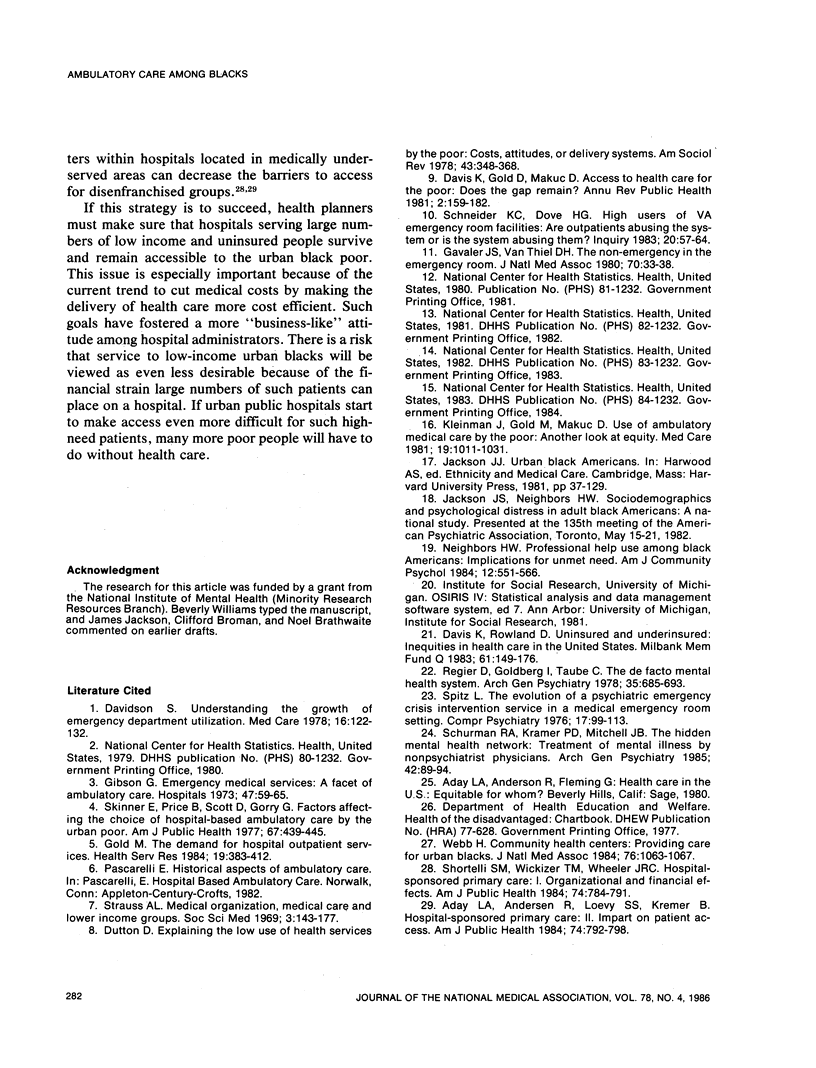Abstract
This paper examines how sociodemographic factors (income, education, employment status, age, gender, insurance coverage, and place of residence) are related to the use of hospital emergency rooms for serious personal problems in a nationally representative sample of adult black Americans. Bivariate analyses indicated that low income, unemployed, and older respondents were most likely to use the emergency room. Gender, education, insurance coverage, and place of residence were not related to emergency room use. Multivariate analyses revealed that the relationship of age to utilization could be explained by the high prevalence of physical health complaints among the old. The poor and unemployed remained significantly more likely (than the non-poor and those with jobs) to use the emergency room when all other predictors were taken into account. The implications of these findings for health services delivery to the urban black poor and the general illness behavior of black Americans are discussed.
Full text
PDF







Selected References
These references are in PubMed. This may not be the complete list of references from this article.
- Aday L. A., Andersen R., Loevy S. S., Kremer B. Hospital-sponsored primary care: II. Impact on patient access. Am J Public Health. 1984 Aug;74(8):792–798. doi: 10.2105/ajph.74.8.792. [DOI] [PMC free article] [PubMed] [Google Scholar]
- Davidson S. M. Understanding the growth of emergency department utilization. Med Care. 1978 Feb;16(2):122–132. doi: 10.1097/00005650-197802000-00004. [DOI] [PubMed] [Google Scholar]
- Davis K., Gold M., Makuc D. Access to health care for the poor: does the gap remain? Annu Rev Public Health. 1981;2:159–182. doi: 10.1146/annurev.pu.02.050181.001111. [DOI] [PubMed] [Google Scholar]
- Davis K., Rowland D. Uninsured and underserved: inequities in health care in the United States. Milbank Mem Fund Q Health Soc. 1983 Spring;61(2):149–176. [PubMed] [Google Scholar]
- Dutton D. B. Explaining the low use of health services by the poor: costs, attitudes, or delivery systems? Am Sociol Rev. 1978 Jun;43(3):348–368. [PubMed] [Google Scholar]
- Gavaler J. S., Van Thiel D. H. The non-emergency in the emergency room. J Natl Med Assoc. 1980 Jan;72(1):33–35. [PMC free article] [PubMed] [Google Scholar]
- Gibson G. EMS: a facet of ambulatory care. Hospitals. 1973 May 16;47(10):59–66. [PubMed] [Google Scholar]
- Gold M. The demand for hospital outpatient services. Health Serv Res. 1984 Aug;19(3):383–412. [PMC free article] [PubMed] [Google Scholar]
- Kleinman J. C., Gold M., Makuc D. Use of ambulatory medical care by the poor: another look at equity. Med Care. 1981 Oct;19(10):1011–1029. doi: 10.1097/00005650-198110000-00004. [DOI] [PubMed] [Google Scholar]
- Neighbors H. W. Professional help use among black Americans: implications for unmet need. Am J Community Psychol. 1984 Oct;12(5):551–566. doi: 10.1007/BF00897212. [DOI] [PubMed] [Google Scholar]
- Regier D. A., Goldberg I. D., Taube C. A. The de facto US mental health services system: a public health perspective. Arch Gen Psychiatry. 1978 Jun;35(6):685–693. doi: 10.1001/archpsyc.1978.01770300027002. [DOI] [PubMed] [Google Scholar]
- Schneider K. C., Dove H. G. High users of VA emergency room facilities: are outpatients abusing the system or is the system abusing them? Inquiry. 1983 Spring;20(1):57–64. [PubMed] [Google Scholar]
- Schurman R. A., Kramer P. D., Mitchell J. B. The hidden mental health network. Treatment of mental illness by nonpsychiatrist physicians. Arch Gen Psychiatry. 1985 Jan;42(1):89–94. doi: 10.1001/archpsyc.1985.01790240091010. [DOI] [PubMed] [Google Scholar]
- Shortell S. M., Wickizer T. M., Wheeler J. R. Hospital-sponsored primary care: I. Organizational and financial effects. Am J Public Health. 1984 Aug;74(8):784–791. doi: 10.2105/ajph.74.8.784. [DOI] [PMC free article] [PubMed] [Google Scholar]
- Skinner T. J., Price B. S., Scott D. W., Gorry G. A. Factors affecting the choice of hospital-based ambulatory care by the urban poor. Am J Public Health. 1977 May;67(5):439–445. doi: 10.2105/ajph.67.5.439. [DOI] [PMC free article] [PubMed] [Google Scholar]
- Spitz L. The evolution of a psychiatric emergency crisis intervention service in a medical emergency room setting. Compr Psychiatry. 1976 Jan-Feb;17(1):99–113. doi: 10.1016/0010-440x(76)90060-2. [DOI] [PubMed] [Google Scholar]
- Strauss A. L. Medical organization, medical care and lower income groups. Soc Sci Med. 1969 Aug;3(2):143–177. doi: 10.1016/0037-7856(69)90001-8. [DOI] [PubMed] [Google Scholar]
- Webb H., Jr Community health centers: providing care for urban blacks. J Natl Med Assoc. 1984 Nov;76(11):1063–1067. [PMC free article] [PubMed] [Google Scholar]


